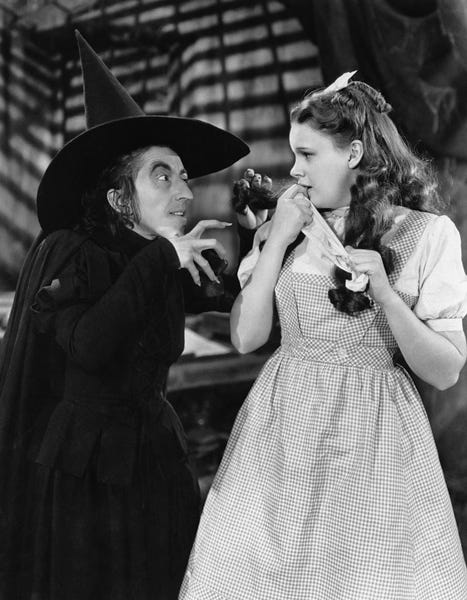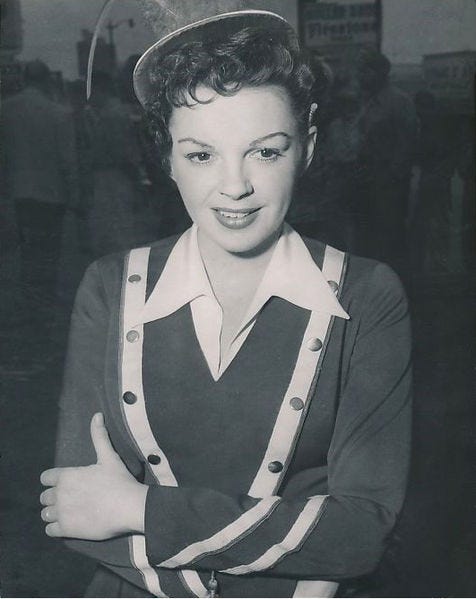The Strings of Judy Garland’s Heart
This month marks the 100th anniversary of the birth of Judy Garland. She was a Hollywood star like none other, who captured America’s heart in The Wizard of Oz (1939) and never let go.
Tragically, she died 53 years ago today at the too-young age of 47, the victim of drug addictions not of her own making. As her good friend Betty Hutton said, “In movies… Anything to get you on. If it takes a pill or a drink, they could care less. And, that’s the God’s truth. They don’t care what you take to get on. And, that’s sad. Because Judy was just a young kid and she was overweight and they gave her what they called diet pills and that’s the same thing as speed.”[1]
Betty would famously take over from Judy in Annie Get Your Gun (1950), when Judy was in the throes of prescription pill addictions. It was a pill-popping culture Betty got caught up in later, in Vegas, when, overcoming hurt feelings, she became closer to Judy, both tormented by the same demons — a problem that, of course, plagues our culture to this day. Judy’s life, about which I wrote on the 40th anniversary of her death for Big Hollywood, per below, (revised), offers a roadmap to healing and recovery.
**********
Washington, DC, June 22, 2009—Thirty years after Judy Garland—“Dorothy”—first publicly performed “Over the Rainbow” on June 29, 1939, previewing the soon-to-be-released Wizard of Oz, this quintessential girl-next-door reached for more sleeping pills and hoped-for sleep, only to be, mercifully, granted eternal rest.
She always wanted to be “glamorous,” forgetting her far-surpassing appeal as the very essence of America.
Her story, the final earthly chapter ending forty years ago today, embodies American triumph and tragedy.
Born Frances Ethel Gumm on June 10, 1922, in Grand Rapids, Michigan, her life nearly ended in 1921 after her parents’ marriage was rocked by revelations of her father’s homosexual infidelity.
But family physician Dr. Marcus Rabwin told Frank Gumm, “you go back to your wife and tell her I said she must have this baby.” The “powerful” Garland “force field,” as fellow MGM star Ann Miller put it, was evidently already at work.
“Baby” Gumm first stole hearts when, at age 2½, she performed “Jingle Bells” before an audience, discovering to her delight that, besides her father, her other great love was performing and making people happy.
She just couldn’t stop singing; so, her father finally had to carry her off the stage.
The family soon decamped to a desert California town north of Hollywood after her father was “caught with a young boy.” There, Ethel sought solace from her troubled marriage by single-mindedly devoting herself into making the “Gumm Sisters” stars.
Needless to say, little Frances was the standout—their big break coming in 1929 with four one-reel shorts. But when comedian George Jessel evoked howls of laughter just by mentioning their name, he suggested they take New York Drama critic Robert Garland’s surname; Frances took her first name from Hoagie Carmichael’s popular song “Judy.”
On November 16, 1935—six months after Metro Goldwyn Mayer’s Louis B. Mayer signed up “Judy Garland”—she sang her first professional rendition of “Zing! Went the Strings of My Heart,” live on coast-to-coast radio, as her father lay dying. Dr. Rabwin, who 14 years earlier had advised the family to bring their daughter to term, called Judy to let her know her beloved father would be listening—radio waves being their last physical “connection.” He died early the next morning.
The young, 4’11” Garland came to studio executives’ attention when she sang “You Made Me Love You” to Clark Gable at MGM’s party celebrating his 35th birthday—a rendition she repeated, while looking adoringly at Gable’s photograph, in the all-star extravaganza Broadway Melody of 1938.
Bandleader Artie Shaw famously summed up Judy’s talent, singing and dancing her way into America’s hearts, telling her, “You become the song.”
So, too, she became the tragedy of American culture—force-fed uppers and downers, plus diet pills, by five different doctors so she could keep up the pace of performance demanded by her MGM bosses who were giddily beside themselves with her money-making potential.
MGM hit the jackpot when it paired Garland with Mickey Rooney in a string of “backyard musicals.” This winning formula, first showcased in the ironically titled 1937 B movie Thoroughbreds Don’t Cry, was followed by Love Finds Andy Hardy, leading to eight more films featuring this adorable, dynamic duo.
Dr. Rabwin’s wife, Marcella, then working at MGM, asserted, “They didn’t mean to addict her. They were trying to get a picture finished.” Yet, the hard truth is, in the process of finishing the picture they laid the groundwork for Judy’s early demise.
As E.Y. Yip Harburg, Wizard of Oz lyricist, explained, “A picture is one of the most devastating things to your nervous system.” Even more so for Judy. As Robert Goulet said, “No one came close to her because she was so vulnerable.”

Her very vulnerability—she required constant reassurance she was, indeed, talented and pretty, given her high-strung, insecure nature, exacerbated by her teenage loss of paternal affirmation—was the source of her greatness. This mega-talented star was all heart and just poured herself into her performances. But, combined with all the barbiturates and amphetamines, it was a toxic mix. As Oscar Levant wrote in his 1969 book, The Unimportance of Being Oscar, “at parties, Judy could sing all night, endlessly... but when it came time to appear on a movie set, she just wouldn’t show up.”
In 1940, after Judy collapsed on the set of Strike Up the Band, in desperate need of months-long rest, she was given only weeks.
Besides her flagging energy, her tendency to show up late rankled her bosses, and on June 17, 1950, a week after she turned 28, MGM cut its prized star loose—the last straw being the demands of Royal Wedding (1951). Thus, began a series of incredible comebacks, starting with her dazzling concert tour, including her history-making star turn at the London Palladium.
Judy had her great film comeback with A Star Is Born (1954), but it was a short-lived success, especially given the backstage backstabbing as the “Studio System,” like Judy, was imploding. With the old controls gone, the ham-handed editing process deprived the film of much of its artistry. (Though, as the cut of “Zing! Went the Strings of My Heart” in Listen, Darling shows, they did not always get it quite right even then.)

Predictably, the demons soon returned, and, this time, overcoming them became nigh impossible.
Betty—while a lesser star, albeit possessing the same booming talent, paternal void, and extremely sensitive nature—almost died of a drug overdose some four years after Judy’s death, only to be “saved” by Fr. Peter Maguire, who helped her play the role of a lifetime—“Being Beautiful Betty.”
And, while Judy didn’t get the help she needed, surely she was helping her friend, Betty, from heaven, as she nearly imploded.
*******
Mary Claire Kendall is author of Oasis: Conversion Stories of Hollywood Legends, published in Madrid under the title También Dios pasa por Hollywood. She recently finished Oasis II and is now working on a biography of Betty Hutton’s life.
[1] Guy Giampapa “Hollywood Backlot” Interview with Betty Hutton, March 8, 1979.



